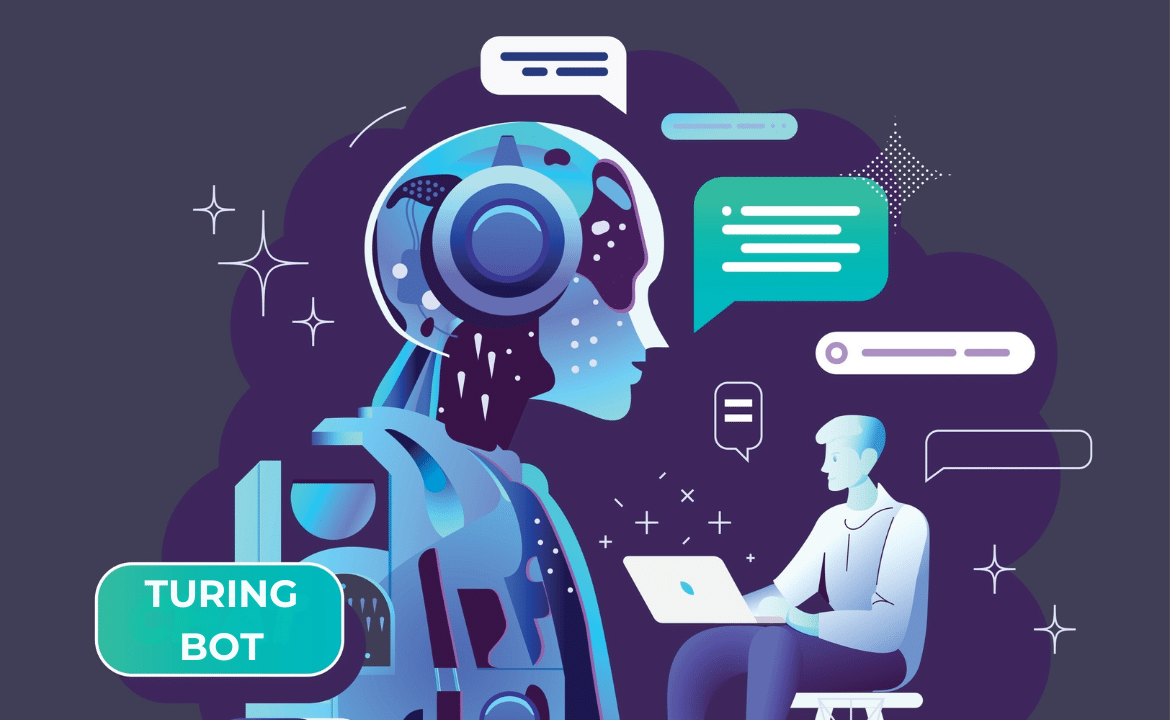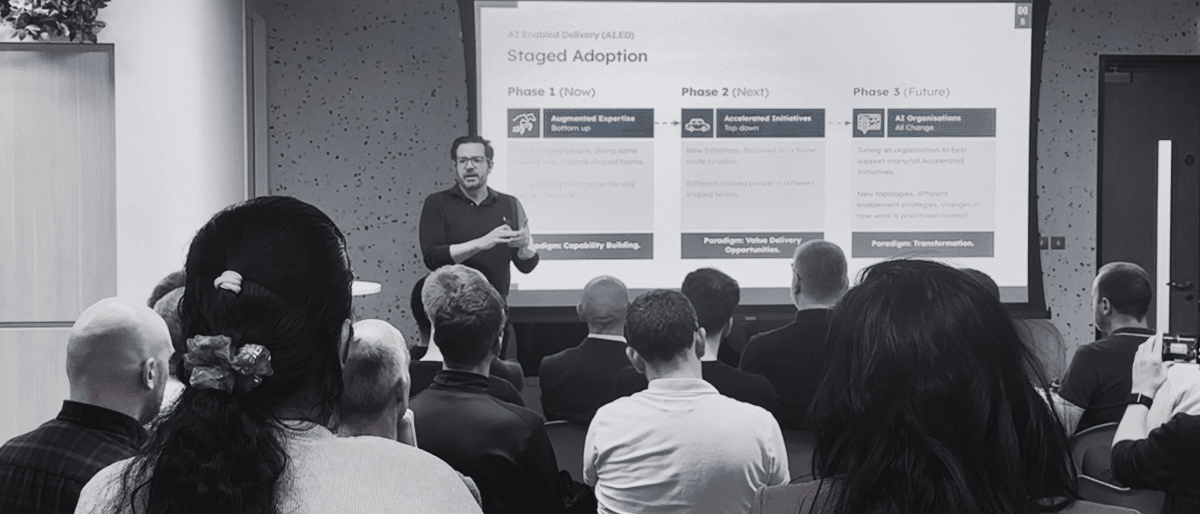This is the first in a three-part series exploring Agent Oriented Architecture. Part Two will provide a fully deployable example with code walkthrough. Part Three will dive deep into implementation questions and challenges.
We find ourselves at a fascinating inflection point in enterprise software evolution. Organisations are successfully deploying AI to augment human workflows; developers code faster with Cursor, analysts process data more efficiently with Claude, customer service scales with chatbots. This “faster horses” approach, referencing the possibly apocryphal Henry Ford quote, is delivering real value today and represents a sensible starting point for AI adoption.
But what comes next? While augmenting human workflows is a valid strategy for now, forward-thinking leaders should be asking: What happens when we flip the paradigm? What does it mean to build AI-native workflows—not human workflows with AI augmentation, but AI workflows with human augmentation?
This question leads us to Agent Oriented Architecture (AOA)—a fundamental reimagining of how enterprise systems should be designed, built, and operated when AI agents become first-class citizens. This isn’t about abandoning current strategies, but about preparing for what’s coming.
The current landscape: Building faster horses (and why that’s okay for now)
Today’s AI tools focus on augmentation, and for good reason. Cursor helps developers write code faster. Claude and ChatGPT help knowledge workers research and write more efficiently. Copilot helps programmers autocomplete their thoughts. These tools deliver immediate value by enhancing existing workflows without requiring fundamental restructuring.
Even our more sophisticated agent frameworks follow this pattern. LangChain and LangGraph excel at creating linear, orchestrated workflows where AI assists in predefined processes. An agent researches vacation destinations, another books flights, a third creates itineraries. The workflow is predetermined, the steps are sequential, and the human remains the orchestrator.
This approach makes perfect sense as a starting point. It minimises disruption, provides measurable ROI, and helps organisations build AI capabilities. But it’s inherently limited—we’re optimising existing processes rather than reimagining them. Smart organisations should excel at building faster horses today while preparing for the automotive age tomorrow.
Introducing Agent Oriented Architecture
Agent Oriented Architecture represents a paradigm shift in how we conceive of enterprise systems. Instead of applications built from services or components, we envision platforms composed of autonomous agents that discover, communicate, and collaborate dynamically to achieve business objectives.
This isn’t simply Service Oriented Architecture with AI sprinkled on top. While SOA gave us reusable services with rigid contracts, AOA gives us intelligent agents with dynamic capabilities. Where SOA required predetermined orchestration, AOA enables emergent collaboration. Where SOA struggled with evolution and adaptation, AOA thrives on it.
The core components of AOA
At the heart of AOA are Business Logic Agents—autonomous entities responsible for specific areas of business capability. Unlike traditional services that simply execute predefined operations, these agents understand intent, make decisions, and adapt their behaviour based on context.
These agents register themselves in an Agent Registry—not the rigid UDDI directories we remember from the SOA era, but a dynamic vector store that semantically encodes agent capabilities. When an agent needs a capability, it doesn’t look up a predefined service—it searches for agents that can fulfil its intent based on meaning rather than exact specification.
Each agent advertises its capabilities through Agent Cards—rich metadata that describes not just what the agent can do, but how it prefers to work, what kinds of problems it excels at, and how it can be engaged. These cards enable true dynamic discovery, where agents find collaborators based on semantic matching rather than exact specifications.
How it works in practice
Imagine a user expressing the intent: “I need a comprehensive analysis of our Q3 performance compared to our competitors.”
In a traditional system, this would trigger a predefined workflow. In an AOA system, something far more interesting happens:
- The initial agent receives the intent and queries the registry for agents capable of “business performance analysis”
- A specialised analytics agent responds, but it doesn’t try to do everything itself
- The analytics agent discovers and engages data agents that understand internal metrics
- It finds market intelligence agents that can gather competitive data
- It collaborates with visualisation agents to create compelling presentations
- Throughout this process, agents negotiate capabilities, share context, and adapt their approaches
The workflow emerges from agent capabilities rather than being predetermined. If new data sources become available, new agents can join the ecosystem without changing any existing code. If better visualisation techniques are developed, they’re automatically incorporated.
Why AOA is different
Beyond linear orchestration
Traditional agent frameworks, even sophisticated ones like LangGraph, excel at creating predetermined workflows. They’re essentially flowcharts with AI-powered nodes. AOA takes a fundamentally different approach—there is no flowchart. Agents discover and engage each other based on capabilities and context.
This mirrors how human organisations actually work. When you ask a colleague to prepare a report, you don’t specify every step. You trust them to find the right resources, engage the right experts, and deliver the result. AOA brings this same flexibility to software systems.
The platform, not the application
Most AI agent implementations today are application-specific. You build a customer service bot, a data analysis tool, or a code generator. Each lives in its own silo with its own logic.
AOA envisions agents as platform services that can be discovered and used by any application. The same data analysis agent that helps create quarterly reports can assist with customer segmentation, supply chain optimisation, or financial forecasting. Agents become reusable building blocks for intelligent systems.
Tool-specific intelligence
One of the key insights driving AOA is that large language models struggle with deciding when to use tools versus their internal knowledge. They’ll often hallucinate answers instead of calling available functions, or invoke tools unnecessarily when a simple response would suffice.
AOA agents are designed differently. Each agent is essentially a specialist that understands its domain deeply and knows exactly which tools to use when. A financial analysis agent doesn’t just have access to calculation tools—it embodies the intelligence to know when and how to use them effectively.
The architectural benefits
Testability at scale
One of SOA’s promises was improved testability through service isolation. AOA actually delivers on this promise. Each agent has discrete capabilities that can be unit tested independently. You can verify that a data agent correctly retrieves and transforms information without needing to test an entire workflow.
True replaceability
In microservices architectures, services are theoretically replaceable, but in practice, changing one service often requires updates to its consumers. AOA agents communicate through semantic intent rather than rigid interfaces, making them genuinely replaceable. As long as a new agent can fulfil the same intents, it can seamlessly replace an existing one.
Avoiding the super-agent trap
It’s tempting to build agents with vast capabilities—a single “business intelligence agent” that can do everything. This path leads to the same maintenance nightmares as monolithic applications. AOA’s registry-based discovery naturally encourages specialised agents that do one thing exceptionally well.
Emergent scalability
Traditional systems scale by adding more instances of the same components. AOA systems scale by adding new capabilities. Need better financial analysis? Add specialised financial agents. Want improved customer insights? Deploy customer analytics agents. The system becomes more capable without becoming more complex.
Preparing for the future landscape
The shift from automobiles didn’t just replace horses—it fundamentally transformed society, enabling suburbanisation, transforming retail with out of town shopping, and reshaping social patterns. Similarly, AOA won’t just make software development faster; it will enable entirely new ways of operating businesses.
Forward-thinking organisations should begin preparing now:
- Start with architectural experiments: While maintaining current augmentation strategies, create sandbox environments to explore agent-based architectures. Build proof-of-concepts that demonstrate emergent workflows.
- Invest in semantic infrastructure: The shift from rigid interfaces to semantic communication requires new capabilities. Organisations should begin building knowledge graphs, developing semantic search capabilities, and training teams in intent-based design.
- Rethink governance models: Traditional IT governance assumes predetermined workflows and fixed interfaces. Agent-oriented systems require new approaches to security, compliance, and quality assurance that accommodate dynamic discovery and emergent behaviour.
- Develop agent literacy: Just as organisations had to develop web literacy, then mobile literacy, they’ll need agent literacy. This means understanding how to design for agent collaboration, how to specify intent rather than implementation, and how to maintain human oversight of autonomous systems.
In this future, the boundaries between human and AI work blur completely. Teams won’t have discrete roles but fluid capabilities extended by the agents they can access. Work will happen in parallel as multiple agents tackle different aspects of problems simultaneously. Some agents might even compete, with the best solutions naturally emerging.
The journey ahead
We’re in the early stages of this transformation. The protocols are emerging—Model Context Protocol (MCP) for tool access, Agent-to-Agent (A2A) Protocol for collaboration. Early implementations show promise. But the real work of reimagining enterprise systems around agent-oriented principles has just begun.
This series will explore how to make this vision real. In part two, we’ll build a working AOA system, walking through the code and architecture decisions that bring these concepts to life. In part three, we’ll dive deep into the practical challenges: How do agents establish trust? How do we maintain human oversight? What patterns emerge for agent communication? How do organisations transition from augmentation to true agent orientation?
The shift from human-augmented to AI-native workflows represents one of the most significant transformations in the history of enterprise software. Organisations that excel at building faster horses today while preparing for the agent-oriented future will have a decisive advantage.
The journey from augmentation to transformation has begun. The question isn’t whether to start, but how quickly you can begin preparing for what’s next.




